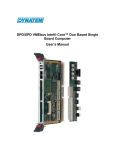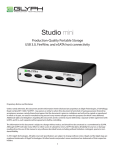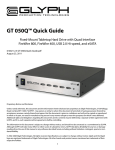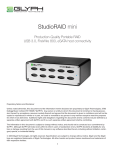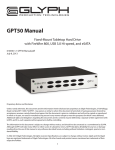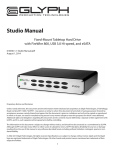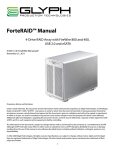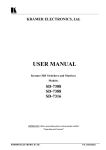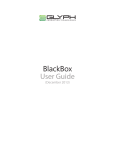Download Glyph PortaGig 50 SSD 512GB
Transcript
PortaGig 50 and SSD Quickstart Production-Quality Portable Storage FireWire 800, USB 2.0, eSATA host connectivity 610033-1.5 PortaGig 50 Quickstart.pdf June 9, 2011 Proprietary Notice and Disclaimer Unless noted otherwise, this document and the information herein disclosed are proprietary to Glyph Technologies, 3736 Kellogg Road, Cortland NY 13045 (“GLYPH”). Any person or entity to whom this document is furnished or having possession thereof, by acceptance, assumes custody thereof and agrees that the document is given in confidence and will not be copied or reproduced in whole or in part, nor used or revealed to any person in any manner except to meet the purposes for which it was delivered. Additional rights and obligations regarding this document and its contents may be defined by a separate written agreement with GLYPH, and if so, such separate written agreement shall be controlling. The information in this document is subject to change without notice, and should not be construed as a commitment by GLYPH. Although GLYPH will make every effort to inform users of substantive errors, GLYPH disclaims all liability for any loss or damage resulting from the use of this manual or any software described herein, including without limitation contingent, special, or incidental liability. © 2010 Glyph Technologies. All rights reserved. Specifications are subject to change without notice. Glyph and the Glyph logo are registered trademarks of Glyph Technologies. All other brands and product names mentioned are trademarks of their respective holders. 1 Contacting Glyph Please use the following contact information to contact Glyph and its distributors. Glyph USA offers phone support Monday through Friday, 8:00 am to 5:00 PM Eastern Time. Note: DO NOT ship any return goods to the mailing addresses below unless you have a valid RMA number. All goods will be refused delivery unless a valid RMA number is displayed on the outside of the package. United States of America Glyph Technologies 3736 Kellogg Rd. Cortland, NY 13045 USA Phone: +1 607-275-0345 Fax: +1 607-275-9464 www.glyphtech.com Sales Contact [email protected] Technical Support: [email protected] Unpacking Your PortaGig 50 Your Glyph PortaGig 50 and accessories are packaged in a sturdy shipping container. Please inspect the container for evidence of shipping damage and mishandling. If the container is damaged, file a report with the carrier or dealer immediately. Do not attempt to unpack and operate your PortaGig 50 until the carrier or dealer confirms the damage. If the container is in good condition, proceed with unpacking the PortaGig 50. Verify that all of the items described in the next section are present and in good condition. If any of the items you expect to find in your container is missing or damaged, contact the dealer before proceeding any further. In any case, do keep the shipping container and all packing materials in a safe place. The PortaGig 50 package includes: PortaGig 50 Hard Drive FireWire 800 (9-pin to 9-pin) cable USB Cable (Y-cable, uses two USB ports for necessary power) Universal AC external power supply Note: Glyph Manager Software is not included with the PortaGig 50. It can be downloaded from www.glyphtech.com. Features 7,200 RPM and 5,400 RPM models available SSD models available Bus-powered with FireWire 800 and USB Small, portable, aluminum case runs quietly with fanless design Rear power switch Applications: Field recording, moving audio, video, graphics, and prepress files Includes universal power supply 3 Year Warranty 2 Year Free Basic Data Recovery* 1 Year Advance Replacement in USA (Continental 48 states) *While Glyph is not obligated to recover lost data, we always give it our best effort. Nonetheless, we can’t guarantee we’ll always be successful. 2 Specifications Part Number 7,200 RPM: PG621B-x (x = drive capacity) 5,400 RPM: PG624B-x (x = drive capacity) Solid State Drive: PG62SB-x (x = drive capacity) Interface (2) FireWire 800 (IEEE 1394b) 9-pin ports (1) USB 2.0 Hi-speed (device-side) port (1) eSATA 3Gbit/s port Bridging Chip Oxford 936 Maximum Transfer Rate eSATA port: 3 Gbit/s Sustained Transfer Rate up to 76MB/sec (FW800) up to 177MB/sec (eSATA) Dimensions H 1.7” x W 4.8” x D 3.6” ConfigurationPortable enclosure Weight 1.2 lb. / 0.56 kg (HDD Version) Power Supply Universal 100-240v 50/60 Hz OS Compatibility Mac OS 8.6, 9.X, 10.X Microsoft Windows 98SE, 2000, XP, Vista, 7 Modern Unix-based, Linux, or BSD Warranty3 Years 2 Years Free Basic Data Recovery* 1 Year Overnight Advance Replace in USA (Continental 48 states) Content Creation Applications Qualified with Final Cut Pro, Avid Media Composer, Adobe Premiere, and all major audio production packages that support FireWire storage, including Digidesign Pro Tools, Steinberg Nuendo and Cubase, Apple Logic, MOTU Digital Performer, Cakewalk Sonar, Sony Vegas. About the PortaGig 50 The PortaGig 50 is a bus-powered hard drive. With its tiny enclosure, it’s small enough to fit into a pocket, and powerful enough to support high track-count audio sessions. With FireWire 800, eSATA and USB 2.0 interfaces, PortaGig 50 is compatible with Mac, Windows and Linux systems. Designed with a fanless, light aluminum enclosure, it allows you to work on the road easily and reliably. If bus power is not available or is insufficient, you can use the included power supply. Capacities and Speeds PortaGig 50 drives are available in 7,200 and 5,400 RPM models, as well as SSD models. All models of the PortaGig 50 perform well in an audio environment, however the SSD models have the highest performance. The 7,200 RPM models have slightly higher track count compared to the 5,400 RPM models due to their higher transfer rates. Ports On the rear of the PortaGig 50 there are two FireWire 800 ports, one eSATA port, and a USB 2.0 port. Officially, FireWire 800 ports are IEEE 1394b ports that run at up to 800Mbits/sec. One of these ports should be connected to your computer, and the other should be connected to other downstream FireWire devices. It doesn’t matter which port you connect to the computer, they are functionally identical. If your computer has a FireWire 800 port, use the provided FireWire 800 9-pin cable. If your computer has a FireWire 400 port only, you can use a FireWire 800 to FireWire 400 converter cable, available from Glyph (part# CAB-FW800-9/6-2). If your computer doesn’t have any FireWire ports you will need to purchase a FireWire adapter card. Check the Glyph web site for suggestions. If you choose to connect your drive using USB 2.0, use the supplied USB cable. Note that the USB cable is a “Y” cable: it has one end that connects to the drive and two ends that can be connected to the computer. Since one USB port often does not supply enough USB bus power for the PortaGig 50, you can plug both ends into your computer if needed. The fastest interface on the PortaGig 50 is the eSATA port. If you choose to connect your PortaGig 50 using eSATA, you will need an eSATA port on your computer. Glyph sells various eSATA cards, please check the website for details. The PortaGig 50 does not ship with an eSATA cable. 3 Bus Power Bus-powered with FireWire 800 or USB for optimum compatibility, it also includes an eSATA port for the fastest speed possible, up to 100MB/s. eSATA is not a bus-powered interface, however, you can use the eSATA connection for data transfer while simultaneously using the FireWire 800 connection to power the drive. This allows the fastest connection possible AND bus power from FireWire. An external power supply is included with the PortaGig 50 if bus power is not available. PortaGig 50 can be run successfully using FireWire and/or USB bus power supplied by many notebook computers, however Glyph can’t guarantee compatibility with all notebooks due to differing bus power specs. If you want to guarantee PortaGig 50 will work, use the included DC supply. You can also try using the USB “Y” cable (see above). Glyph Manager Software Glyph Manager software constantly monitors the drive and enclosure health, notifying you if there is a problem, allowing you to work on the road easily and reliably. Connected by FireWire 800, USB or eSATA, it reports the drive’s health and temperature as a background task. It is not necessary to install Glyph Manager for the PortaGig 50 to function, but is very convenient in troubleshooting, notifying you if your drive needs attention. Note: Glyph Manager Software is not included with the PortaGig 50. It can be downloaded from www.glyphtech.com. Front panel LED The PortaGig 50 front panel has a bi-color LED. The LED will display solid blue when power is on. The LED will flash blue when there is disk activity. The LED will flash or display a solid red color when error conditions exits with the drive or enclosure. Any error that results in the system state “Halted” generates a solid red LED on the front panel of the drive. All other errors result in the blinking red LED. All errors will animate the Glyph ball in the dock under OS X or generate an error balloon under Windows, if Glyph Manager software is installed. About eSATA • eSATA is an external interface technology that grew from the internal SATA I interface. • The PortaGig 50 eSATA port supports speeds up to 3 Gb/sec (300 MB/sec), much faster than FireWire 400 or FireWire 800. • Shielded eSATA cables up to 2 meters in length are available. • eSATA cables are different than SATA I cables, they are shielded and cannot be used with internal SATA I connectors. • eSATA uses a “point-to-point” connection, therefore each eSATA drive needs to be connected to its own eSATA port. • Most computers do not have built-in eSATA, so you’ll need a PCI card to connect your drive with eSATA. Glyph sells various eSATA cards. About FireWire FireWire is an implementation of the IEEE 1394 serial bus standard. It not only supports automatic configuration (“plug and play”) and hot-swapping of devices, it’s fast, and best of all it’s reliable for audio/video as well as for computer peripherals. FireWire supports peripherals in a tree-like structure, and it allows peer-to-peer device communication—e.g. between a scanner and a printer—to take place, without using system memory or the CPU. With FireWire you can hook up to 63 devices to the same bus, with cable lengths of up to 4.5 meters (14 feet) including internal cabling, allowed between devices. Its cable is convenient and can also carry power. This allows low-consumption devices to operate without a separate power cord, by using power supplied by other devices on the bus. About FireWire 800 • FireWire 800 supports speeds up to 800 Mb/sec, twice as fast as FireWire 400. • If your computer does not have built-in FireWire 800, you’ll need a PCI card to achieve a true FireWire 800 connection. • Most 800 ports are Bi-Lingual, which means they speak both FireWire 400 and FireWire 800. • If you connect a 400 device to an 800 device, you will be running at 400 speed maximum. • FireWire is forward-compatible and back-compatible. • Beta cables are used to connect 800 devices to 800 devices. • Bi-Lingual cables are available to connect 400 devices to 800 devices. • Bi-Lingual cables have a 9-pin Bi-Lingual connector at one end and a 4-pin or 6-pin FireWire 400 connector at the other end 4 Frequently Asked Questions Q: Do I need any drivers to use the PortaGig 50? No drivers are required for FireWire on Mac or Windows. No drivers are required for USB on Mac OS or Windows XP/2000/Vista/7. A driver is required for USB on Windows 98/SE, and is available for download from www.glyphtech.com. Look under in the support/ downloads section of the web site. Q: My Windows computer doesn’t show the drive in My Computer. What’s up? The default format on the PortaGig 50 is for the Macintosh, and Windows doesn’t recognize it. Once you have connected the PortaGig 50 to your Windows PC, you have to re-initialize it for use with Windows. For Windows XP/2000/Vista/7, that’s going to be NTFS format; for Win98/SE, that will be FAT32 format (Windows XP and 2000 can also read FAT32). Detailed instructions for reinitializing your drive are on the Glyph web site, or you may choose to follow the quick Windows formatting directions in the next section. Q: My Macintosh OS X computer shows the drive on the Desktop but it says I can’t write to it. What’s up? If you have formatted the PortaGig 50 for Windows (NTFS), Mac OS X will recognize it as an NTFS drive, but can only read from it and can’t write to it. Once you have connected the PortaGig 50 to your Mac OS X computer, you should re-initialize it for use with Macintosh. Instructions for re-initializing your drive are on the Glyph web site. Q: How do I know if I have the correct version of Glyph Manager? To get the latest version of Glyph Manager, go to the support section of www.glyphtech.com and download the version for your operating system. Q: Do I need to have Glyph Manager installed to use the PortaGig 50? No, Glyph Manager is used for monitoring drive health only. It is not necessary to install Glyph Manager, but it is recommended. Q: How can I make my drive work across Windows and Mac platforms? The only file system that works well between Mac OS and Windows is FAT 32, otherwise known as MS-DOS file system. This is a native Windows file system, but Mac OS 9 and X will mount FAT 32 volumes. Mac OS 9 and 10.1.x would only work with FAT 32 partitions less than 32GB. While Mac OS 10.2.x increased that limitation to 128GB, it wasn’t until Mac OS 10.3.x that you could use FAT 32 partitions of any size. Mac OS 10.3.x can additionally read NTFS volumes but cannot write to them. See next question for information specific to Pro Tools software. Mac OS 9 Formatting Instructions Since Glyph drives come pre-formatted for Macintosh you don’t need to format them on installation. If you decide to reformat or partition your drive at a later date, you can use the Erase Disk command in the Mac OS 9 operating system. This command will erase all the data on a volume and create a new file system. Erase disk will not allow you to re-partition a FireWire drive or create a different volume structure than what was previously there. Caution: This procedure will destroy any data currently on the drive. Before formatting a drive, save any important data it contains. 1. Select the volume by clicking on it once in the Finder 2. Go to the Special menu and select Erase Disk... The Erase Disk dialog box opens to verify your decision to erase the disk. 3. In the Name field, enter the new name for the disk or leave the name as it is. 4. In the Format drop-down menu, choose an Extended volume and click “Erase”. 5 Mac OS X Formatting Instructions Since Glyph PortaGig 50 drives come pre-formatted for Macintosh you don’t need to format them on installation. If you decide to reformat or partition your drive at a later date, use Disk Utility (supplied with the Mac OS X operating system). Caution: This procedure will destroy any data currently on the drive. Before formatting a drive, save any important data it contains. 1. Open Disk Utility: -Double click on your internal hard drive mounted on the desktop -Open Applications Folder > Utilities Folder > double click on Disk Utility 2. Select your PortaGig 50 drive(s) from the list on the left. The top entry represents the FireWire device and the entry underneath it represents the volume associated with that device. Click on the top device which will say something like “XXXGB Glyph Technologies”. 3. Click the “Erase” tab on the right side of the screen. 4. Choose the desired volume format from the drop-down list. Glyph recommends the default “Mac OS Extended (Journaled)”. 5. Click in the “Name” field and type the desired name for the drive. This name will identify the drive on the desktop 6. Click the “Install Mac OS 9 Disk Driver” button if you would like your drive to compatible with OS 9. 7. Click the “Erase” button to erase your drive. Your new drive should automatically mount on the desktop as a Glyph volume. Windows 2000 / XP / Vista / 7 Formatting Instructions 1. Right-click My Computer and click Manage. 2. In the Computer Management window, under Storage, click Disk Management. The Write Signature wizard pops up. 3. Use the wizard to write a signature to the new drive. If you want only one partition we suggest using a primary partition and selecting the maximum size. In most cases you’ll want to use NTFS volumes, this is the default for most versions of Windows. Choose FAT32 if you want to use the drives with Windows 98 or ME , or if you want to use the drive with Windows and Mac OS. 4. Formatting will take a few minutes, after which your drive will be ready to use. Windows 98 / 98SE Formatting Instructions 1. From your computer’s task bar, go to Start > Programs > MS-DOS Prompt. 2. At the prompt, type fdisk and press Enter. You’ll see a long message about disk support. 3. Enter Y (type Y and press Enter). 4. You are invited to make a choice. Enter 5 to change the current fixed disk drive. MS-DOS displays the connected disk drives. 5. Enter the number of the disk that has no corresponding drive letter. 6. You are invited to make a choice (same list as in Step 3). Enter 1 to create a primary DOS partition. Your computer verifies the drive’s integrity, after which you are asked to choose whether you want to use all the space available. 7. Enter Y to opt for using the maximum available space. Your computer again verifies the drive’s integrity. 8. When the drive’s integrity has been verified, press ESC (Escape) three times to exit fdisk. 9. At the prompt, type exit. 10. Restart your computer. Your new drive is now ready to use. 6






